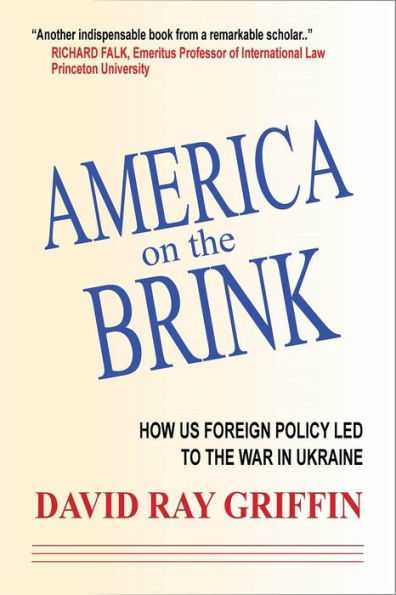America on the Brink: How US Foreign Policy Led to the War in Ukraine
The American government, through its media, has convinced most Americans to support the Ukrainian government. This books shows why this is a mistake: The United States promised Mikhail Gorbachev that NATO would not expand “one inch eastward”; and there had been ample warnings, by George Kennan and others, that moving NATO eastward, especially moving into Georgia and Ukraine, would cause problems for Russia.
In Ukraine prior to 2014, Ukrainian and Russian speakers were coexisting tolerably well. But in 2013 and 2014, neocons in Obama’s administration engineered a coup, with help from neo-Nazis, turning Ukraine into a Russia-hating nation. The war in Ukraine began that year (not in 2022, when Russia attacked in order to protect the Russian-speaking regions under attack by the new coup government in Kiev).
Although this book is primarily about the war in Ukraine, it also shows how, in one sense, the war in Ukraine is simply one more instance in the trajectory of American imperialism. as illustrated by previous US interventions in Iran, Guatemala, Cuba, Brazil, Greece, Dominican Republic, Panama and Iraq.
In another sense, this war reveals just how committed America is to maintaining a unipolar world order: Because this war illustrates that America is willing to threaten nuclear holocaust. it is almost as if people in the U.S. State Department and military believe that life is not worth living unless the US can control the world.
1143072700
In Ukraine prior to 2014, Ukrainian and Russian speakers were coexisting tolerably well. But in 2013 and 2014, neocons in Obama’s administration engineered a coup, with help from neo-Nazis, turning Ukraine into a Russia-hating nation. The war in Ukraine began that year (not in 2022, when Russia attacked in order to protect the Russian-speaking regions under attack by the new coup government in Kiev).
Although this book is primarily about the war in Ukraine, it also shows how, in one sense, the war in Ukraine is simply one more instance in the trajectory of American imperialism. as illustrated by previous US interventions in Iran, Guatemala, Cuba, Brazil, Greece, Dominican Republic, Panama and Iraq.
In another sense, this war reveals just how committed America is to maintaining a unipolar world order: Because this war illustrates that America is willing to threaten nuclear holocaust. it is almost as if people in the U.S. State Department and military believe that life is not worth living unless the US can control the world.
America on the Brink: How US Foreign Policy Led to the War in Ukraine
The American government, through its media, has convinced most Americans to support the Ukrainian government. This books shows why this is a mistake: The United States promised Mikhail Gorbachev that NATO would not expand “one inch eastward”; and there had been ample warnings, by George Kennan and others, that moving NATO eastward, especially moving into Georgia and Ukraine, would cause problems for Russia.
In Ukraine prior to 2014, Ukrainian and Russian speakers were coexisting tolerably well. But in 2013 and 2014, neocons in Obama’s administration engineered a coup, with help from neo-Nazis, turning Ukraine into a Russia-hating nation. The war in Ukraine began that year (not in 2022, when Russia attacked in order to protect the Russian-speaking regions under attack by the new coup government in Kiev).
Although this book is primarily about the war in Ukraine, it also shows how, in one sense, the war in Ukraine is simply one more instance in the trajectory of American imperialism. as illustrated by previous US interventions in Iran, Guatemala, Cuba, Brazil, Greece, Dominican Republic, Panama and Iraq.
In another sense, this war reveals just how committed America is to maintaining a unipolar world order: Because this war illustrates that America is willing to threaten nuclear holocaust. it is almost as if people in the U.S. State Department and military believe that life is not worth living unless the US can control the world.
In Ukraine prior to 2014, Ukrainian and Russian speakers were coexisting tolerably well. But in 2013 and 2014, neocons in Obama’s administration engineered a coup, with help from neo-Nazis, turning Ukraine into a Russia-hating nation. The war in Ukraine began that year (not in 2022, when Russia attacked in order to protect the Russian-speaking regions under attack by the new coup government in Kiev).
Although this book is primarily about the war in Ukraine, it also shows how, in one sense, the war in Ukraine is simply one more instance in the trajectory of American imperialism. as illustrated by previous US interventions in Iran, Guatemala, Cuba, Brazil, Greece, Dominican Republic, Panama and Iraq.
In another sense, this war reveals just how committed America is to maintaining a unipolar world order: Because this war illustrates that America is willing to threaten nuclear holocaust. it is almost as if people in the U.S. State Department and military believe that life is not worth living unless the US can control the world.
29.95
In Stock
5
1

America on the Brink: How US Foreign Policy Led to the War in Ukraine
271
America on the Brink: How US Foreign Policy Led to the War in Ukraine
271
29.95
In Stock

Product Details
| ISBN-13: | 9781949762723 |
|---|---|
| Publisher: | Clarity Press, Incorporated |
| Publication date: | 05/20/2023 |
| Pages: | 271 |
| Product dimensions: | 6.00(w) x 9.00(h) x 0.75(d) |
About the Author
From the B&N Reads Blog
